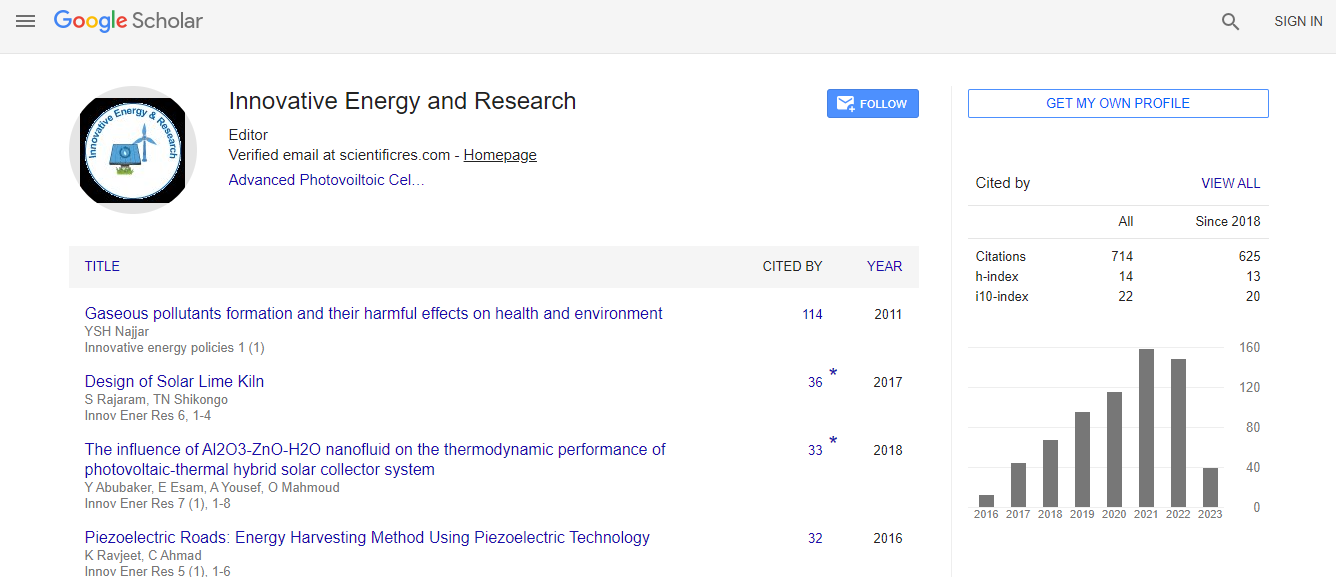Our Group organises 3000+ Global Conferenceseries Events every year across USA, Europe & Asia with support from 1000 more scientific Societies and Publishes 700+ Open Access Journals which contains over 50000 eminent personalities, reputed scientists as editorial board members.
Open Access Journals gaining more Readers and Citations
700 Journals and 15,000,000 Readers Each Journal is getting 25,000+ Readers
Google Scholar citation report
Citations : 712
Innovative Energy & Research received 712 citations as per Google Scholar report
Innovative Energy & Research peer review process verified at publons
Indexed In
- Google Scholar
- Open J Gate
- Genamics JournalSeek
- RefSeek
- Hamdard University
- EBSCO A-Z
- Publons
- Euro Pub
- ICMJE
Useful Links
Recommended Journals
Related Subjects
Share This Page
Hydrocarbon source potential of tertiary carbonaceous shale, shale and siltstone of eastern Chenor, Penyu basins, Pahang, Malaysia
Joint Event on 2nd International Conference on Renewable Energy and Resources & Energy Materials and Fuel Cell Research
Yousif M Makeen and Wan Hasiah Abdullah
University of Malaya, Malaysia
Posters & Accepted Abstracts: Innov Ener Res
Abstract
Malaysia and Asian region have a number of petroleum-bearing sedimentary basins commonly associated with coal and carbonaceous shale strata. Shales are the common source rocks of conventional petroleum resources whilst coal although a source for conventional liquid hydrocarbons is more widespread as unconventional resources, such as cannel coal and coal bed methane (CBM). Coals within the oil & gas producing provinces of Malaysia and SE Asian region, in general, are known to be oil-prone. However, with the inevitable decline in conventional petroleum, remaining hydrocarbons will be more difficult to find and more expensive to develop. Set against the backdrop of world energy consumption projected to increase by 49% by 2035, alternative sources of energy are being sought. Petroleum geoscientists are exploring unconventional source/reservoir systems such as the carbonaceous shale, oil shale, tight sand, coal bed methane and fractured basement. In this study, shale, and siltstone which are an importance sedimentary faces for hydrocarbon exploration in the eastern Chenor, Pahang has been investigated using organic geochemical and petrological methods as well as Micro-CT, SEM (Scanning Electron Microscope). The Tertiary sediments of eastern Chenor show a general trend of low thermal maturity based on vitrinite reflectance measurements (<0.5 %Ro) and Tmax (<435oC). Organic petrological studies revealed that analyzed carbonaceous shale and shales are rich in liptinite macerals (>20 vol. %) such as aliginite (Botryococcus algae), sporinite, cutinite and amorphous organic matter indicating oil-prone Type I and Type II kerogens. Pyrolysis data also show a trend from predominant oil-prone Type I and II kerogens to a mixed oil and gas-prone Type II-III kerogens within the studied samples except for the siltstones samples which have low HI value indicating no potential for hydrocarbon generation. The EOM result shows that all the carbonaceous shale samples possess excellent values for the bitumen/EOM and hydrocarbon (HC) content. The studied shale samples have very good petroleum potential. However, analyzed siltstones show poor to fair petroleum potential based on for the bitumen/EOM and hydrocarbon (HC) content. This is supported by plots of TOC content versus extractable organic matter (EOM) and hydrocarbon yields versus TOC content commonly used in estimating the hydrocarbon generative potential of the source rocks.Biography
Dr. Yousif Makeen began his geology studies in 2008 at the University of Malaya, Malaysia. In 2011 he received the BSc degree in Applied Geology from University of Malaya. His MSc was converted to PhD by the University Senate based on his excellent performance. His professional career began in 2015 when he received his PhD from University of Malaya. His research interests are in oil, Source rock Characterization and Petroleum Systems Modeling. Throughout the years he has presented his research work in Europe, the Middle East, and Southeast Asia. He has published 24 papers in ISI journals and conducted many consulting projects for major oil companies. He is currently a Postdoctoral Research Fellow at the University of Malaya.
E-mail: makeen.geo@hotmail.com

 Spanish
Spanish  Chinese
Chinese  Russian
Russian  German
German  French
French  Japanese
Japanese  Portuguese
Portuguese  Hindi
Hindi 
